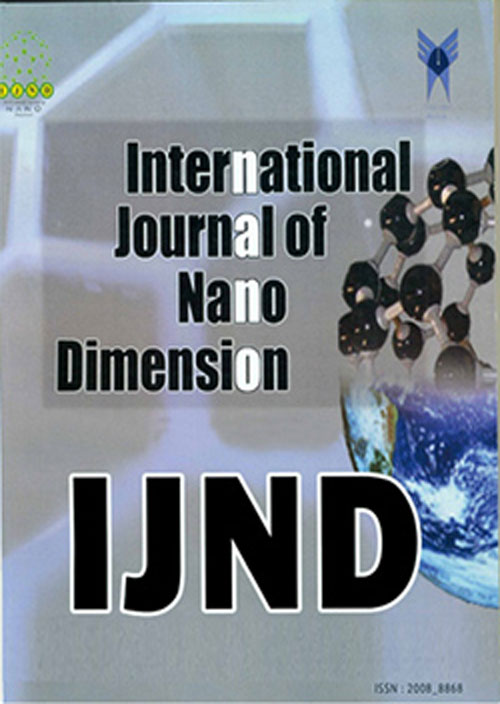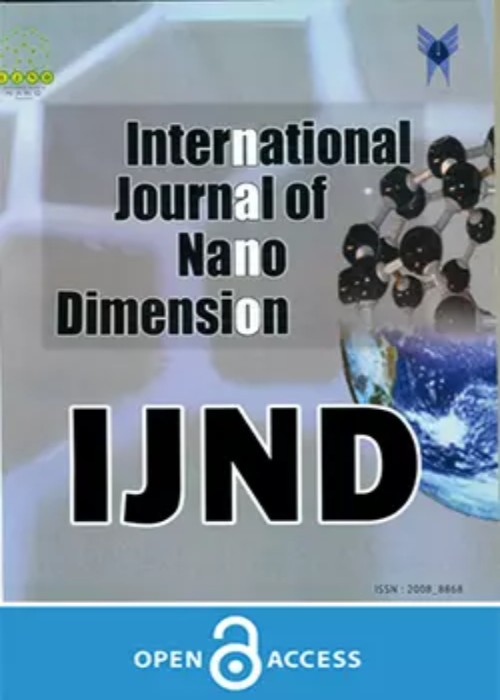فهرست مطالب

International Journal of Nano Dimension
Volume:12 Issue: 3, Summer 2021
- تاریخ انتشار: 1400/03/23
- تعداد عناوین: 10
-
-
Pages 186-202
In this paper, a study of the existing SRAM (Static Random Access Memory) cell topologies using various FET (Field Effect Transistor) low power devices has been done. Various low power based SRAM cells have been reviewed on the basis of different topologies, technology nodes, and techniques implemented. The analysis of MOSFET(Metal Oxide Semiconductor Field Effect Transistor), FinFET( Fin Field Effect Transistor), CNTFET (Carbon Nano Tube Field Effect Transistor), and TFET (Tunnel Field Effect Transistor) based SRAM cells on the basis of parameters such as stability, leakage current, power dissipation, read/write noise margin, access time has been done. HSPICE, TCAD, Synopsys Taurus, and Cadence Virtuoso were some of the software used for simulation. The simulations were done from a few µms to 7nm technology nodes by different authors.
Keywords: CNTFET, FinFET, Leakage Current, MOSFET, SRAM, TCAD, TFET -
Pages 203-210The advantage of using plants and plant metabolites over expansive and toxic chemical methods for nanoparticles (NPs) synthesis has fascinated researchers to investigate the mechanisms of bio-reduction of metal ion for various biomedical applications. Herein, pineapple leaf extract was used for the synthesis of silver (Ag) and bimetallic silver-gold (Ag-Au) core-shell NPs which offered an economic and sustainable synthetic route compared to toxic chemical method. The synthesized NPs were further subjected to UV-visible spectrometer to investigate the formation kinetics at specific time intervals. To reveal the presence of various functional groups in the leaf extract responsible for bio-reduction of Ag ions and subsequent formation of core-shell nanostructure, FTIR study was conducted. Morphology and structural properties were examined by TEM and XRD. Further, disc diffusion test was employed to reveal the antibacterial effectiveness of NPs against Gram-positive (Staphylococcus aureus) and Gram-negative (Escherichia coli) bacteria. The study revealed that both Ag and Ag-Au NPs are good antibacterial candidates and bacterial sensitivity to NPs was found to vary depending on bacterial species.Keywords: Ag-Au, Antibacterial, Core-shell, Disk-Diffusion, Green synthesis, Pineapple
-
Pages 211-221
Surface grafting of nanocarriers could modulate their properties and characteristics. As carbon nanotubes synthesis is a very tricky process and requires high-end methods, hence the present investigation was aimed to develop an eco-friendly method for synthesis carbon nanotubes (CNTs) and subsequent surface grafting for enhanced drug delivery application. The present study elaborates two-step chemical modifications; wherein the first step is catalytic cleavage of natural precursor in the presence of ferrocene and the second step involve chemical grafting of Acyclovir (ACV) as a model drug to understand the drug release behaviour. The catalytic cleavage of sugarcane cubes (natural precursor) was carried out in a closed copper tube, which prevents oxidation and results in a conversion of tubular nanostructures to amorphous carbon. The covalent attachment of ACV on purified CNTs (fCNTs) was done using carbodiimide chemistry. The preliminary Uv-Vis absorbance spectra defined at 260 nm was arised due to π-π* stacking of aromatic C-C bonds. The Fourier Transforms Infrared Spectroscopy (FTIR) indicated the hydroxyl stretch at 3300 cm-1 while amide I bond formation was observed at 1672 cm-1. The XRD spectra confirmed successful synthesis of CNTs. The calculated average crystallite size (Scherer equation) of synthesized CNTs was found to be 42.84 and 44.45 nm; it was also in accordance with the morphological observation as confirmed simultaneously using SEM analysis. The covalently attached ACV was released up to 80% during 8h of in vitro drug release study. The surface grafting potential of CNTs was found to be promising compared to other nanomaterials.
Keywords: Acyclovir, Amorphous Carbon, Carbodiimide Chemistry, Natural Precursor, Purification -
Pages 222-238Geometry, global energetic and dipole moment of the studied structures 1-4 in the ground state are calculated using the DFT/B3LYB/6-311++G (d,p) level of theory. It has been uncovered that compounds containing 1, 2, 3-thiazaphosphinine and 1, 2-azaphospholes bearing a Chromone ring structure displays noteworthy biological properties. The studied compounds 1-4 are non-planar, as indicated from the dihedral angles. Using frontier molecular orbital (FMO) analysis, various spectroscopic and quantum chemical parameters are evaluated. Besides, absorption energies, oscillator strength, and electronic transitions of 1, 2, 3-thiazaphosphinine and 1, 2-azaphospholes 1-4 molecules have been derived at TD-DFT/CAM-B3LYP/6-311++G (d, p) computations utilizing a PCM and measured in different solvents polar and non-polar experimentally in Uv-Vis spectra. The second-order perturbation interactions between donor and acceptor MOs of the ground state and the natural bond orbital (NBO) analysis show a localization and delocalization of electron density, intermolecular Charge Transfer CT character of n-π*, π-π* transitions. The calculated at the same level of theory which NLO, α, Δα and first order β were showed promising optical properties. For the understanding of reactivity points, the molecular electrostatic potential surfaces (MEPS) plots have been computed. All the calculations have been performed in the gas phase.Keywords: DFT, TD-DFT, B3LYB, 6-311++G (d, p), MEPS, NLO, NBO analysis, Optoelectronic Application, Uv-Vis Spectra, 3-Thiazaphosphinine, 2-Azaphospholes
-
Pages 239-251Natural bioactive compounds, such as essential oils, with antimicrobial or antioxidant activity, have received considerable attention recently, especially with rising concerns on the safety of synthetic food preservatives. However, due to their low water solubility and structural stability, their incorporation into water-based food formulations are limited, as is the other lipophilic functional compounds. Moreover, in order to investigate the possible synergistic effects of the most combinations of the essential oils, the aim of this study was to prepare water-dispersible licorice-garlic-fennel essential oil nanoparticles using nanoemulsion systems through a low-energy self-emulsifying technique. The effects of essential oil proportions in the oil phase on nanoemulsion characteristics were also evaluated using a simplex-centroid mixture design, and various empirical models were developed to predict changes in the obtained nanoemulsion characteristics. Finally, multi-goal optimization was applied to obtain the most desired composite nanoemulsions with the least mean particle size, polydispersity index, turbidity, and the greatest antioxidant and bactericidal activity. Based on this optimization analysis, the most desired product was obtained using 39% licorice, 40% garlic, and 21% fennel essential oil as oil phase. The results also confirmed the synergistic effects of selected essential oils towards one another, which the nanoemulsions with two- and three- components oil phase exhibiting higher antibacterial and antioxidant activity than those with a single-component oil phase. The prepared nanoparticles had reasonable physical stability at 5 ± 1 °C during 40 days of storage.Keywords: Composite Oil Phase, Essential oil, Fennel, Garlic, licorice, Mixture Design, Nanoemulsion
-
Pages 252-271The thermophysical properties and thermal performance of water- and ethylene-glycol-based nanofluids containing and CuO nanoparticles were examined. Nanofluids were prepared at four concentrations (1- 4 vol%) using an electric mixer and magnetic stirrer, and the thermophysical properties were measured. Surfactants were used to improve stability. The transient hot-wire method (KD2-Pro device), Dynamic Light Scattering (DLS), and Ostwald viscometer (ASTM D445-06) were used to measure the resulting thermal conductivity coefficient, nanoparticle diameter, and nanofluid viscosity, respectively. The experiments were carried out in the 20 to 50 °C temperature range. Adding 1 wt% sodium dodecyl sulfate (SDS) to the CuO–water and the same amount of sodium dodecylbenzene sulfonate (SDBS) to the –water nanofluid were found to stabilize them for 20 and 22 days, respectively. Increasing the nanoparticle volume fraction, raising the temperature, and reducing nanoparticle diameter were found to increase the thermal conductivity coefficient. The density also increases with the nanoparticle volume fraction in the base fluid increasing. Moreover, at the same volume fraction, the CuO–water nanofluid had a higher density than –water. Better base fluid thermal properties amplify the effect on the nanofluid's thermal conductivity coefficient. The actual thermal conductivity coefficient was determined by comparing model predictions of the coefficient.Keywords: Al2O3, CuO, Nanofluids, nanoparticles, Thermal conductivity coefficient
-
Pages 272-278Natural Circulation Loop (NCL) which is also called as a thermosyphon system is the heat transfer loop which uses no pump or external device to drive the loop fluid. In the present paper, a comparative study on thermal characteristics of two loop fluids viz. water and Al2O3/water nanofluid is made. Experiments are conducted on in-house designed test rig. Thermo-hydraulic behaviour of loop fluid is presented. Two parameters such as heat input, nanofluid concentration are varied in order to study their individual and combined effects. It is concluded that Al2O3/water nanofluid as loop fluid results in higher mass flow rates as compared to the water. Different derived quantities such as Nusselt number and Grashof number are calculated. Quantitative comparison is made between water and Al2O3/water nanofluid. Time to reach steady state is reduced by 22 % using Al2O3/water nanofluid as loop fluid when compared with water. Mass flow rate and Grashof number of the Al2O3/water nanofluid based NCL are enhanced by 6.75% and 26% respectively, when compared with water-based NCL at 1000W heat input. At the heater, the temperature gradient is reduced by 30.2% due to the improved thermal and transport properties of Al2O3/water nanofluid when compared with water at 1000 W heat input. As particle concentration increases from 1% to 5%, Nusselt number increases from 10.1 to 20.1, for the heat input of 1000W.Keywords: Grashof Number, Heat transfer enhancement, Nanofluid, NCL, Nusselt number, Thermal performance
-
Pages 279-292In this study, a new nanoscale U-shaped tunnel field-effect transistor (US TFET) structure is proposed. In order to start the design process, the drain region of the conventional US TFET is divided into two distinct parts with N+ and N- doping which is named the drain doping engineering (DDE). It is considered that the tunneling barrier at the channel-drain junction is increased and consequently the ambipolar current is decreased considerably. To continue the design process, the dual work function (DW) in the DDE-US TFET has been used to ameliorate the DC characteristics and the cutoff frequency. Moreover, we have used the metal implant (MI) in the source-side oxide of DDE-DW-US TFET as a technique to improve the device for high-frequency and low-power applications. The 2-D TCAD simulation results not only indicate the superiority of the proposed structure (DDE-DW-MI-US TFET) compared to others in terms of the high-frequency performance, but also illustrate the improvement of the DC parameters. Finally, the proposed device has been investigated by increasing the length of implanted metal in the source-side oxide. It is found that selecting the appropriate length contributes significantly to improve high-frequency performance.Keywords: Ambipolar current, Drain Doping Engineering, Dual Work Function, Metal Implant, Nanoscale U-Shaped Tunnel Field-Effect Transistor (US TFET)
-
Pages 293-304
In this work, PP+CdS/ZnS transparent hybrid polymer nanocomposites were synthesized and studied. The nanocomposites were characterized by X-ray diffraction (XRD), scanning electron microscopy (SEM), energy dispersive (EDS), and UV-spectroscopy analysis. It was found that the bandgap of PP+1%CdS/ZnS; PP+3%CdS/ZnS, and PP+5%CdS/ZnS; PP+10%CdS/ZnS nanocomposites is 5.2 eV, 5.1 eV, 4.6 eV, respectively. SEM analysis showed that the ZnS and CdS nanoparticles are evenly distributed in the polymer matrix. Furthermore, the average size of nanoparticles in the PP+3%CdS/ZnS, PP+5%CdS/ZnS nanocomposite is 40-54 nm, 29-56 nm, respectively. Photoluminescence properties of hybrid PP+CdS/ZnS nanocomposites were also investigated. It was established that introduction of ZnS and CdS semiconductor nanoparticles into the polypropylene matrix leads to expanding the region of the spectral sensitivity of hybrid nanocomposites. The photosensitivity of PP+CdS/ZnS nanocomposite films was also investigated.
Keywords: Cadmium sulfide, nanocomposite, nanoparticles, Photoluminescence, polymer, Polypropylene, Zinc sulfide -
Pages 305-309
The devices with additional gates like Fin Field effect transistor (FinFET) provide higher control on subthreshold parameters and are favorable for Ultra large-scale integration. Also, these structures provide high control on current through the channel and with minimum leakage. In this paper we designed a FinFET with high-K gate dielectric material i.e Hafnium oxide as gate oxide. A comparison of similar sized transistor with Air and Silicon dioxide as gate material is performed. The comparison is mainly in terms of performance parameters like transconductance, subthreshold slope, and drain current characteristics. There is an increase in ON current on using a high-K dielectric material and subsequently an improvement in other parameters like subthreshold slope, transconductance and intrinsic gain.
Keywords: FinFET, Hafnium Oxide, High-k Dielectric, Subthreshold Slope, Transconductance


